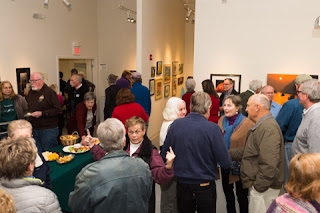By Guest Blogger, Stan Divorski Stan Divorski is an artist and avid art and photography collector who lives in Lewes, Delaware. He has a PhD in Psychology from Northwestern University, a Certificate in Painting and Drawing from the Corcoran College of Art and Design in Washington DC and has studied modern art curating at the Chelsea College of Arts in London.
All art or photography lovers must see this joint exhibition of the Rehoboth Art League and the Coastal Camera Club, showing the work of photographers who are members in both organizations.
The artists display a creative — and at times playful — willingness to explore what the medium has to offer. Each artist shows a willingness to experiment with ground, presentation, image manipulation and staging to create uniquely effective images. The curators, Jay Pastore and Lee Mills, are to be congratulated for putting together a captivating demonstration of this diversity.
A few examples from this abundance of worthy images are in order. Dick Snyder’s “Florentine Ceiling” sets the tone by challenging the viewer to make sense of his black and white abstraction of a cathedral ceiling. Dizzying perspective, rich pattern, narrow tonal range and frameless canvas support simultaneously suggest M.C. Escher, a medieval tapestry and a Southeast Asia temple wall painting.
A few examples from this abundance of worthy images are in order. Dick Snyder’s “Florentine Ceiling” sets the tone by challenging the viewer to make sense of his black and white abstraction of a cathedral ceiling. Dizzying perspective, rich pattern, narrow tonal range and frameless canvas support simultaneously suggest M.C. Escher, a medieval tapestry and a Southeast Asia temple wall painting.
Linda Rosenbluth’s “Out on the Town” at first appears to be an art deco poster of the 1930s, due to saturated neutral colors, rectilinear composition and flat light. Closer examination confirms a photo of a modern urban scene.
Robin Harrison’s “At Rest” depicts a flamingo without the curved neck and stick legs that dominate most images of the bird. Harrison has selected a pose that abstracts the essence of the bird, highlighting its shyness and the textural richness and subtle color variation of its plumage.
 |
| "Reflection" by Brooke Hedge |
Brooke Hedge’s “Reflection” exemplifies how to capture mystery with only minimal editing of a photograph. Traditionally framed and matted, this black and white view of a young woman’s sun dappled reflection could well have been titled “Narcissus” after Ovid’s boy of that name. Its subject is Pre-Raphaelite, and its texture is that of Monet’s brush strokes. The image symbolizes innocent purity, the fleeting nature of beauty and the uncertainty of perception.
Adjacent to Hedge’s work, Leslie Sinclair’s “Woodland Tea Party” takes a less purist approach. The frameless, aluminum mounted image of a tea table in a forest is a light painting (composed of multiple individually lit layers combined to form the final image). Reminiscent of Gregory Crewdson’s large scale, staged cinematic tableau, this smaller work is carefully arranged, conjuring Alice in Wonderland as interpreted by David Lynch.
If this exhibit is representative, The Coastal Camera Club may be more than a club, but rather the beginnings of a school of photography with a vision unique to the Delaware shore.
If this exhibit is representative, The Coastal Camera Club may be more than a club, but rather the beginnings of a school of photography with a vision unique to the Delaware shore.
The Rehoboth Art League, with 1800 members, is Sussex County's first organized cultural arts center. Located on a historic plantation, it encourages artists and arts education and sponsors exhibits and programs.
The Coastal Camera Club, with more than 200 members, serves the Delaware seashore. It encourages and promotes interest in all phases of photography, encourages education in photography, holds contests and presents awards, and promotes the photographic efforts of its membership.
The Coastal Camera Club, with more than 200 members, serves the Delaware seashore. It encourages and promotes interest in all phases of photography, encourages education in photography, holds contests and presents awards, and promotes the photographic efforts of its membership.


